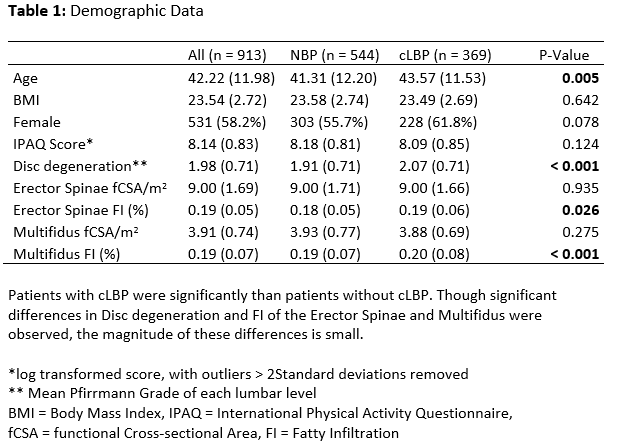German Congress of Orthopaedics and Traumatology (DKOU 2025)
Deutscher Kongress für Orthopädie und Unfallchirurgie 2025 (DKOU 2025)
Paraspinal muscle health and physical activity: Divergent effects on chronic low back pain patients and healthy controls
Text
Objectives and questions: The paraspinal musculature is critical for spinal health. However, the impact of general physical activity on the paraspinal muscles remains unclear. This study aims to investigate how physical activity levels relate to paraspinal muscle morphology and whether effects differ between healthy individuals and those with cLBP.
Material and methods: Participants aged 18 to 64 with and without chronic low back pain (cLBP) were prospectively enrolled from the general population. Physical activity levels were assessed using the International Physical Activity Questionnaire (IPAQ), which reflects activity level in metabolic equivalent (MET). Due to outliers the score was log-transformed and outliers over 2 standard deviations were removed. Paraspinal muscle morphology was measured using axial T2-weighted MRI. Fatty infiltration (FI) was quantified with thresholding methods, and functional CSA (fCSA) was calculated by subtracting fat area from total muscle area, adjusted by patient height (Figure 1 [Abb. 1]). Muscle values are given as the mean of all lumbar levels to reflect overall muscle condition. We used multivariable linear regression to analyze the relationship between physical activity and fCSA and FI of the ES and MF in both healthy individuals and cLBP patients adjusting for age, sex, BMI, and lumbar disc degeneration.
Results: The study included 913 participants: 544 with no cLBP and 369 with cLBP. Detailed demographics are given in Table 1 [Tab. 1]. In the no cLBP group, higher levels of physical activity were associated with an increase in height-adjusted fCSA of the ES (β: 0.29, 95% CI: 0.10 – 0.48, p = 0.003), though no effect was seen in the cLBP group. No significant association with MF morphology was observed in either group (Table 2 [Tab. 2]). The overall explanatory power of the IPAQ score was low overall, explaining a maximum of 1.8% of the variance, in the case of ES fCSA in healthy patients. Analysis at individual muscle levels yielded similar findings, and results were less significant when using non-adjusted fCSA and IPAQ scores.
Discussion and conclusions: This study shows a limited but significant association between physical activity and paraspinal muscle morphology, mainly for the erector spinae (ES) in individuals without cLBP, though effects on FI and the multifidus were minimal. The overall weak explanatory power suggests that general activity alone is insufficient to maintain paraspinal muscle health, with targeted exercise likely playing a greater role. The stronger association in non-cLBP participants indicates that pain-related disuse or neuromuscular changes may alter muscle adaptation in cLBP.







